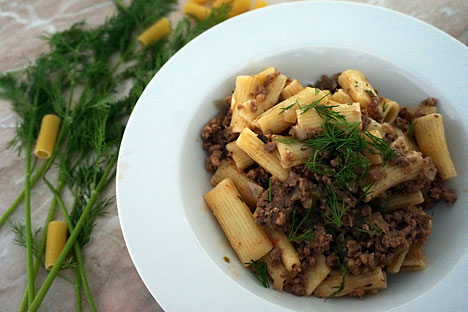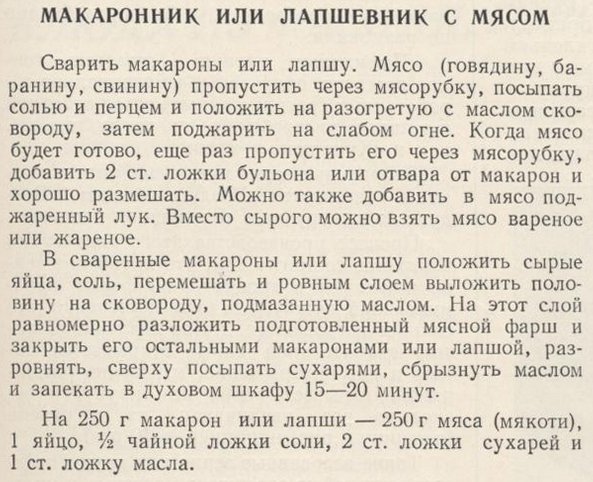Makarony po-flotsky - the meal the sustained the Russian Navy

Makarony po-flotsky
Anna KharzeevaThis piece is part of the Soviet Diet Cookbook, a blog about a modern Russian girl cooking Soviet food. To read more of the series, click here.
There was a period at school when bell bottom pants were all the rage. Looking for ways to fit in, I found a pair of my grandfather’s pants – they were yellow and leathery and went very wide at knee level – I couldn’t have been more excited, as I got the ultimate bell bottoms!
My grandfather owned the rather unusual pair of pants for a Soviet man because he had served in the navy, and in the navy, bell bottoms were common attire for sailors.
The navy gave us more than just a relatively brief obsession with the rather inconvenient pants for our rainy, slushy and snowy climate, but also a dish that spread very widely – makarony po-flotsky, or navy-style pasta.
Unfortunately, my grandfather is no longer around and I can’t ask him, but Granny says he used to tell her that they really did eat a lot of makarony po-flotsky in the navy. The dish is as simple as can be: fried minced or canned meat mixed with pasta. No tomatoes, no cheese, no nothing. It’s nowhere near spaghetti Bolognese, but it does fill you up quickly and requires minimum effort. The ingredients are easy to transport and that’s what is believed to have made it popular with the navy.
“We only had very thick long pasta with a hole back in the day. There were also some ‘seashells’ and a couple other shapes, but no spaghetti or anything like it. The long thick sticks of pasta would just sit in a big open box in shops. One time when your mom was little I took her to a shop in a town near Moscow and there was a box of pasta on the floor – she quietly took one and started chewing on it without anyone noticing! She thought there were so many that taking one wouldn’t hurt. When you bought pasta sticks, they would be wrapped in a paper cone like a bunch of flowers,” Granny told me.
Pasta would be boiled till very soft (the concept of al dente came in quite late and didn’t quite penetrate the Russian kitchen), and often consumed with either cheese or cottage cheese or tomatoes or butter or meat. Granny’s not sure when the meat pasta got its “po-flotsky” name, and the Book just calls it “pasta with meat” – another of the Book’s many naming mysteries!
Around the time I was wearing yellow bell bottoms, my mom took my brother and me to Italy with a group she was guiding. That was where we first saw spaghetti and were entertained for days learning to wrap spaghetti noodles neatly around a fork before fitting them into our mouths. This was quite different from the pasta we were used to, such as makarony po-flotsky, which was handed out for free at City Day celebrations. A tank full of it sat on the “defenders of the air” square in my neighborhood – and everyone would get a free serving of the over-boiled pasta with questionable quality meat. It was delicious! Or so we thought until we tried Italian spaghetti....
These days, spaghetti Bolognese is a signature dish of my husband’s, so I felt a bit shy serving my po-flotski to him. He is a good man and said it was great. A friend who came over later liked it as well, and now I need a few more volunteers to eat the rest – when you make makarony po-flotsky, there always seems to be enough to feed a small armada!
Makaronnik po-flotsky
 The recipe from the Soviet Cook Book, page 243
The recipe from the Soviet Cook Book, page 243
Ingridients
250 grams macaroni or noodles; 250 grams meat; 1 egg; ½ tsp salt; 2 Tbsp breadcrumbs; 1 Tbsp butter
Boil the macaroni or noodles. Put the meat (beef, pork, lamb) through a meat grinder. Season with salt and pepper. Cook in a frying pan over medium heat. When the meat is cooked, put it through the meat grinder again. Add two tablespoons bouillon. You can add chopped onion to the meat. The meat can be boiled or fried.
Combine the macaroni or noodles with the egg and cook in a frying pan with butter. Add the meat, top with breadcrumbs and butter, and put in the oven for 15-20 minutes.
Read more: Who needs Domino’s when you can have Soviet pizza>>>
All rights reserved by Rossiyskaya Gazeta.
Subscribe
to our newsletter!
Get the week's best stories straight to your inbox
